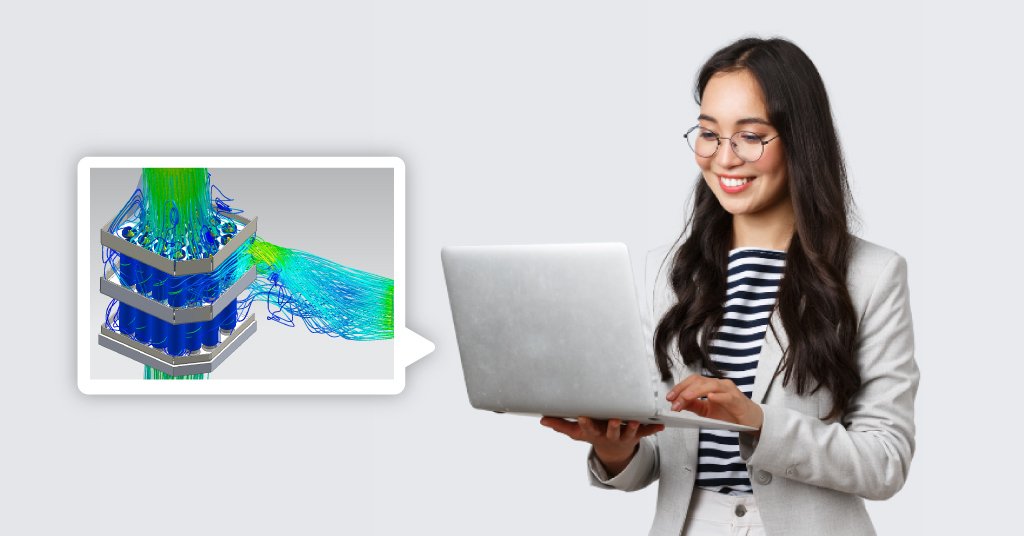Science and technology have advanced drastically over the past few decades, enabling engineers to create more capable and efficient machines/infrastructures than ever.
Computational Fluid Dynamics is one such technology that uses modern and accurate concepts and methods to understand the fluid flow to evaluate the performance of a design and determine its efficiency.
The world we live in is a juncture of interactions between solids, gas, and liquid. Therefore, understanding and abiding by the nature of these elements and their impacts become ubiquitous for successful designs.
Computational Fluid Dynamics or CFD helps understand the flow and fluid transfer in the entire design process, which helps in design optimizations. Let’s see how engineers can utilize this cutting-edge technology for practical applications…
How Does Computational Fluid Dynamics Work?
Computational Fluid Dynamics is a branch of fluid mechanics that uses numerical analysis and algorithms to solve complex problems related to fluid flow. For example, partial differential equations (PDEs) quantify gas and fluid flow.
The PDEs represent high-performing computer software solving mass, momentum, and energy conservation laws. In addition, the simulations of boundary conditions help understand the interaction of liquids and gasses with surfaces.
The CFD software uses Navier-Stokes Equation to solve the problems and obtain solutions. For example, using the FCD software, engineers can solve fluid flow-related problems like flow velocity, density, temperature, and chemical concentrations.
Industries Where CFD is Applied

Professionals across domains in various industries use CFD for accurate and successful designing. Some of them are as follows:
-
CFD is widely used in aerospace engineering, HVAC engineering, electronics manufacturing, cavitation prevention, etc.
-
CFD is used in the chemicals and petrochemical industries by oil and gas engineers to build optimal pipelines for transportation.
-
Meteorologists use CFD to foresee the weather, analyze wind flow, predict natural disasters, etc.
-
In the aerospace engineering, automobile industry, and vehicle manufacturing sectors, engineers use CFD to optimize the design and structure to increase speed safety and maximize design optimizations.
-
Architects use CFD to study wind flow, heat transfer, and other conditions to build safe and environment-friendly constructions and living conditions.
-
Doctors use computational hemodynamic studies to study arterial and venial complications and diseases and a cure.
-
Engineers use CFD in buildings’ HVAC systems, especially in data centers, to facilitate easy heat transfer and optimally regulate the internal temperature of the building.
Practical advantages of CFD
CFD Analysis is widely used in various industries for its immense benefits in component design and construction. Here are some of the advantages:
-
CFD analysis can predict and evaluate the performance of components before integrating them with the main systems.
-
By analyzing the components before installation, designers and engineers can understand and determine modifications and improvements to increase the component’s performance.
-
Parameters and boundary conditions like heating, ventilation, and air conditioning can be used in CFD modeling to accurately analyze the component’s design without needing a physical prototype.
-
Advanced HVAC/IAQ technology requires detailed and more comprehensive data about fluid flow to perform with maximum efficiency.
-
CFD produces more accurate and sufficient data than other theoretical and experimental methods to attain fluid flow data in an occupied zone that meets advanced HVAC/IAQ technology requirements.
-
CFD removes the need for physical prototyping, which is expensive and time-consuming. CFD is an efficient tool for design and construction with reliable results and quick run times.
Practical applications for computational fluid dynamics
CFD Analysis is practically applied in several areas requiring keen analysis and interpretation of component design efficiency and performance. Here are some areas where CFD is used:
-
CFD Simulations are used to detect and prevent cavitation with the help of small thresholds. These conditions are harder to set in the physical world. The designs can be analyzed with keen detail to improve the components’ flexibility, durability, and safety.
-
CFD is used for simulating turbulence and tailoring models to understand component design and study the effects of turbulence on the engineered designs.
-
HVAC units and their components can be examined using CFD analysis to understand their performance in different spaces and configurations.
-
Automobile designers, aerospace engineers, and sports equipment manufacturers use CFD simulations to reduce friction and drag to improve the performance of their products.
-
CFD simulations are used to optimize heat transfer management in automobiles and in electronics like coffee machines to ensure structural integrity and safety of the designs. It can also increase the efficiency of the designs that use heat for combustion or power.
-
Pipelines systems for oil refineries, natural gas pipelines, and residential plumbing can be optimized for fluid flow, safety, and longevity with the help of CFD simulations.
-
CFD simulations help identify the ideal configuration for cooling elements like heatsinks and cooling fans. As a result, they prevent sensitive chips from overheating and ensure the safety and durability of the components.
Final Thoughts
Engineers and professionals can use Computational Fluid Dynamics in various fields to understand component design and performance. It is immensely beneficial to increase efficiency and optimize outputs by running the designs.
The sophisticated software runs the designs within minutes and produces quicker results. This eliminates the need for extensive physical prototyping and helps designers and engineers save time and costs.
Mechartes is a team of CFD experts and analysts who have worked with various projects of diverse natures to aid design optimization and enhance performance. Their years of expertise and industry knowledge on CFD simulations and analytics can help you design efficient and optimized components for your projects. Get in touch with Mechartes today.


 Share
Share  facebook
facebook